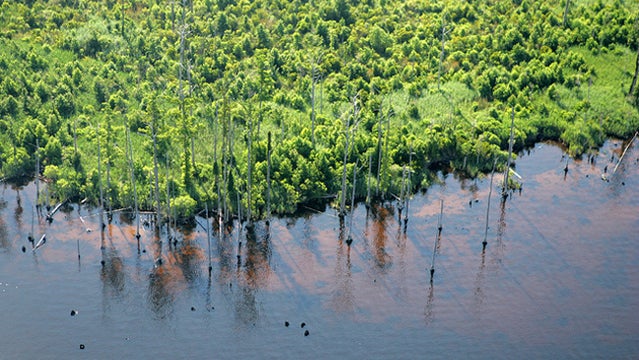The Endangered Species Act turns 40 this year, and the list of species that it has helped federal agencies bring back from the brink of extinction is long and impressive. The authors of this landmark legislation were reacting to rampant development and pollution that was depleting habitats, specifically wetlands. But since 1973, another factor has emerged that is putting myriad species in peril: climate change. One specific result of this shift, sea level rise, is already putting the squeeze on a range of species.
���ϳԹ��� Ethics
Mary Catherine O’Connor and guest writers on environmental issues and the ethics of adventure.Surely, federal agencies can use the Endangered Species Act (ESA) to protect species threatened by climate change, too. Right? Well, it’s complicated, says , associate professor at the University of Maine’s School of Law.
“You’ve got a huge problem with sea level rise and climate change,” Owen says. “If you were naive about political realities, you’d see the ESA as a mechanism for responding to climate change. But the agencies [that are empowered to enforce the ESA] are in a very tough spot because if they were to try to respond to sea level rise, they would have to try to regulate greenhouse gas emissions.” And that, he says, is not politically feasible.
The root issue is not that the ESA is legislatively ineffective, but that the tools it provides agencies are not easily applied to things like sea level rise. In arguing for better protections of, say, the threatened Atlantic piping plover, it’s one thing to ban vehicles from driving on beaches where they nest, but it’s another to try to shut down a nearby coal plant because of the greenhouse gases it is emitting, Owen says. “You could make that legal argument, but the political reaction would be very intense.”
“SHOE-HORNED” SPECIES
Species that have a very limited range or rely on a specific habitat type (known as habitat specialists) are clearly in danger if their homes are both coastal and in low-lying parts of the country. But species that can survive in a wide range of environments (known as habitat generalists)—that have suffered from severely reduced and fragmented habitat thanks to development, road buildings, and other stressors—are in many cases now facing another threat in the form of lapping waves.
This is true of the red wolf, a species that once ranged throughout the Southeast but is now relegated to its reintroduction area in a small peninsula along North Carolina’s northeastern coast, says DeLene Beeland, whose book, , is being published this summer. Only about 100 wild red wolves live in the region, which equals around one percent of its former range.
That the red wolf has persisted as long as it has—despite its endangered status lasting decades, losses from illegal hunting, and its habitat being already so diminished—. But the rising Atlantic will test its survival even more.
A combination of a naturally subsiding landscape (a leftover impact of glaciations) and saltwater encroachment from the coast means that the peninsula, home to the Alligator River National Wildlife Refuge and the nearby Pocosin Lakes National Wildlife Refuge, is losing its forests at a pregnant pace. The soil on the peninsula is made of pocosin peat, which forms a wetlands that are especially vulnerable to saltwater. “When the peat comes into contact with saltwater due to sea level rise, it subsides even further,” Beeland says.
A coastal tree called the Pond Pine is also, unsurprisingly, intolerant of the increasing salinity that surges inland during storms. “The needles start to brown even from saltwater spray,” Beeland says. “Just driving through the refuge, I could see the retreating forests.”
With much of the peninsula sitting just one to three feet above sea level and some projections showing sea level rise meeting or exceeding that, the picture is grim. What will this mean to the red wolf? It could force biologists to seek out a new reintroduction area, even though the current site has been used for more than 25 years, Beeland says.
Of course, the wolf is not the only endangered species threatened specifically by rising waters. The Florida panther is another example—indeed, sea level rise is just another threat in a long list of threats to species throughout the Sunshine State, particularly in the Florida Keys.
Wide-ranging habitat generalists like the red wolf and Florida panther would likely be resilient to many impacts of climate change, Beeland says, but the problem is that we’ve “shoe-horned them into these very small habitats” that are now being further diminished.
ADAPTATION
It’s not just coast-hugging charismatic species that are being threatened, notes Owen, who points to salmon, smelt, and other aquatic residents of the Sacramento river delta. “That beaches are being swallowed is intuitive,” he says, but even a small sea level rise along the Northern California coast will have ramifications for the inland delta, which plays a vital role in the entire state’s fresh-water system (which is already imperiled by agricultural demands).
So can the ESA be modernized such that it could be a stronger tool to fight climate change? Owen says that’s not likely. “For most of the past 40 years, federal agencies have been just defending the Act against changes that would weaken it,” he says. That hasn’t left much time or political leverage to actually make it stronger.
More effective, he says, would be a carbon tax: “In the long run, a cap and trade program will be a better fate for species, rather than looking for changes to the ESA.”
Meanwhile, adaptation programs are focused on to resist rising seas. The Nature Conservancy is partnering with the U.S. Fish and Wildlife Service on a program in which they are establishing oyster reefs to buffer wave action and installing water-control systems that reduce saltwater intrusion into the pocosin wetlands.


